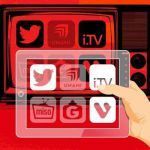How Social Media Is Changing Prime Time TV

It’s easy to talk about how social media is changing the world. What’s harder to put into words is how social media has changed us. Billions of people fill their minutes (which add up into hours) with Facebook, Twitter, YouTube, Instagram, Snapchat, LinkedIn, Pinterest and Vine. But is social media a pastime? Or is it now a fully integrated part of our lives, impacting much more than simply how we interact with technology. A study commissioned by Nokia revealed that the average user checks their smartphone about 150 times each day – and chances are that average user is checking for new updates on their social feeds.
On one hand, we now have more control than ever before over what we consume when it comes to media because we manage our own information networks. Don’t like one take on a particular issue? You can all but banish it from your life. On the other, social media has the potential to broaden a person’s perspective to a near infinite degree. A teen in the US can be friends with a Finnish businessperson. Stock market stories can make their way into a Hell’s Angel’s feed. Each of us is in the driver’s seat – most of the time, that is.
Network television is something of a holdout when it comes to social media. Radio has always been influenced by consumers (think about song requests and call-in talk shows), and as fast as people got used to streaming audio the stations were posting their content for anytime, anywhere listening and sharing, too. Print media is still finding its niche but for the most part, social networks are designed around the written word. Network TV has up until now existed as its own animal, but with the skyrocketing popularity of streaming video something had to give or prime time was going to go extinct.
That hasn’t happened, obviously. The networks are ultimately embracing the “second screen” and recognizing in many cases that the second screen has become the first screen. TV 2.0 as it’s called isn’t a device but rather a way networks (and advertisers) are changing programming and advertising thanks to the social experience empowered by the Internet. First, TV 2.0 acknowledges that people want what they want when they want it. More networks are delivering full episodes of prime time shows via free streaming. Second, it promotes even more social engagement. What promo or ad doesn’t have a hashtag these days? Once upon a time, we talked about our favorite shows with a couple of friends. Now we can talk about them with a couple thousand friends. And finally, TV 2.0 is interactive. When you’re watching on a tablet or phone you can click on an ad for more information or click through to a show’s site directly from a promo.
Television is getting smarter because it has to. We’re already living the smart life with hundreds of synchronous experiences that link our social lives with our social media on any given day. Beamly is the first notable player on the social TV scene – with it, users can follow shows, celebrities, and users; make recommendations and ratings; and chat about what’s on. Chances are it won’t be the last as the networks scramble to figure out what exactly they need to do to compete with the original content now being released by Netflix and Hulu.
However television evolves from this point forward, one thing will remain the same. Prime time used to control our schedules; now to a growing extent, we control prime time.
[image error]



